by Howard Fosdick © FolkFluteWorld.com.
The ocarina is a kind of vessel flute. A vessel flute has an enclosed chamber inside of which air vibrates (or "resonates"). This differs from concert flutes and recorders, which are basically open-ended pipes.
Vessel flutes require that the musician direct his breath onto an edge that splits it to create sound waves. The sound waves then resonate inside the enclosed chamber. This is rather like blowing across the lip of an open pop bottle to produce a tone. You have to hold the bottle at the right angle to properly target the edge of the bottle opening to make a sound.
What distinguishes an ocarina is that it has a mouthpiece that automatically directs the musician's breath into a blade (or labium) that splits his breath to create the sound waves.
Thus, the ocarina is a specific type of vessel flute. It has a mouthpiece or "wind duct" or "fipple" that properly directs the musician's breath, making it easier to play.
The pitch of an ocarina is determined by the size of its enclosed chamber, the sizes of its finger holes, and how hard you blow. By opening or closing the finger holes, you raise or lower the pitch of the sound.
Prehistory
Vessel flutes date back thousands of years. Several sources state that they date to at least 12,000 years ago. Some kinds of primitive clay whistles have been found in central Africa that date to some 30,000 years ago.
Many of the earliest vessel flutes are actually whistles. They produce different sounds by covering finger holes, but they are not tuned to consistently produce the same sound across instruments. In other words, they produce sounds of various pitches but do not play scales or modern music. They pre-date today's musical concepts of a standardized set of notes, or scales.
We thus distinguish between modern ocarinas and the more primitive, unstandardized whistles. Whistles are the ancestors of ocarinas.
These proto-ocarinas have been found in archaeological sites around the world and may have developed independently in several regions. Pre-Columbian Mesoamerica is one such region. (Mesoamerica comprises modern-day Mexico and the northern part of Central America.)
The leftmost photo below shows a ceremonial vessel flute that dates from between 200 to 700 AD. It was discovered in Veracruz, Mexico.
The center photo is an animal effigy whistle. It dates from the El Bosque Phase of the Central Atlantic Watershed, which places it in the range of 100 BCE to 500 AD.
The righthand photo below displays a vessel flute from what is today Columbia. It dates to about 1,300 to 1,500 AD.
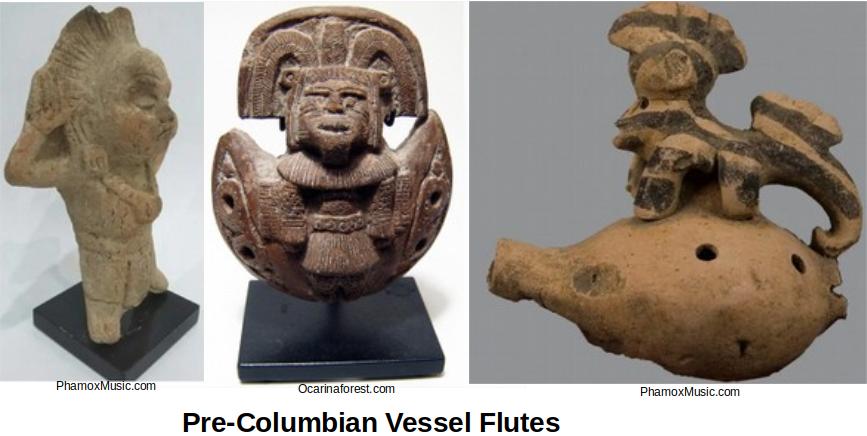
Many whistles shaped like birds or animals have been found from various Mesoamerican cultures, including the Maya, Aztecs, and Inca. Historians believe they probably had a role in various religious or cultural ceremonies.
In this musical video, Dr José Cuellar plays several ancient pre-Columbian vessel flutes so you can hear how they sound. Dr Cuellar has researched early vessel flutes extensively.
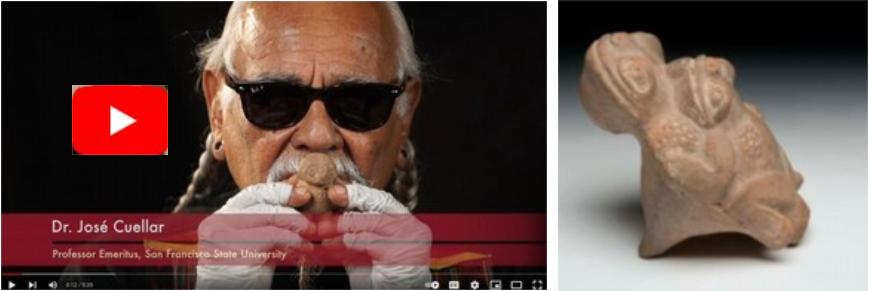
Click to Hear How Ancient Vessel Flutes Sound (Youtube.com, Peabody.Harvard.edu)
Archaeological finds similar to pre-Columbian vessel flutes have been made in India, Egypt, and central Africa. Probably most notable is the ancient Chinese instrument called the Xun. The egg-shaped Xun dates back 7,000 years. You play it by blowing across the hole at the top of the instrument to split your breath. Thus by our definition, it is a vessel flute, but not an ocarina. Xuns are still played today in China.
The Runik Ocarina
The oldest known vessel flute discovered in Europe is called the "Runik Ocarina." It was found in Runik village in Kosovo.
The Runik Ocarina is not actually an ocarina, as it has a Xun-like blow-hole at one end, rather than an ocarina fipple. As with many prehistoric vessel flutes, it's made of baked clay. It is estimated to be about 8,000 years old. Several other similar vessel flutes have been found in eastern Europe.

The Gemshorn
The gemshorn is the first true ocarina from Europe. Unlike the Runik whistle or the Chinese Xun, it directs the player's breath into a labium to produce sound, so it is truly an ocarina. In the above photo, you can see the rectangular notch that splits the player's breath to create sound.
Gemshorns have been unearthed in Germany, Italy, and Hungary. They were carved from the horns of goats, chamois, or other horned animals. Gemshorns date from the 14th and 15th centuries. The instrument has a range of about an octave.
There's not much historical information available on the gemshorn, so it's not clear how widely it spread or when it was actually played. In any case, the instrument faded out by the 16th century. But with a resurgence of interest in historical music, vendors make copies that are sold and played today.
New World Ocarinas Come to Europe
With the conquest of the New World by Hernán Cortés and others, Mesoamerican vessel flutes filtered back to Europe.
Some aver that native American musicians traveled to Europe and played at the court of Emperor Charles V of Spain. And that the reception was so enthusiastic that these musicians then played throughout Europe and even in the court of Pope Celement VII in Rome.
However it happened, there's little doubt that Europeans became much more aware of vessel flutes through their importation from the Americas. Some even started crafting the strange little instrument. But due to its odd looks and limited pitch range, vessel flutes were widely considered toys or musical oddities.
Birth of the Modern Ocarina: 1850s Italy
All this changed when a 17-year-old Italian brick-maker named Giuseppe Donati encountered vessel flutes in the early 1850s. He had a kiln, and he had the clay. And now his inventive young mind had an interesting new proto-instrument to play with.
And that's exactly what he did. Giuseppe shaped his vessel flute into the "sweet potato" or submarine form still predominant today. With its protruding mouthpiece and egg shape, he thought it looked like a little goose. So he called it exactly that in Italian... ocarina.
Guiseppe gave his instruments 10 holes. He started making them in different sizes. He eventually standardized them with modern musical scales, and they became classified as Settimino di Ocarine: C1, G2, C3, G4, C5, G6, C7.
In this notation, the letter denotes the key of the instrument (either C or G), while the number indicates its relative pitch, from highest to lowest. The C3 is what most people today refer to as the "Alto C" ocarina. Its lowest note is the same as the soprano recorder. C5 is an octave lower, so its lowest note is that of the tenor recorder.
These early modern ocarinas can play a full scale, plus all sharps and flats in between.
Guiseppe didn't stop at inventing the modern ocarina. He aggressively popularized his new instrument. He placed his little geese into the hands of professional musicians and formed the “Gruppo Ocarinistico Budriese” (the Budrio Group), which he named after his hometown of Budrio, Italy. GOB played all over Italy and eventually throughout Europe. The tradition of the "ocarina ensemble" was born. More importantly, Mr Donati firmly established the ocarina as a respectable musical instrument throughout Europe.

Giuseppe Donati, One of His Ocarinas, and the Budrio Group (musicologie.org, mfa.org, phamoxmusic)
Becoming Popular in the United States
With ocarinas widespread in Europe, by the 1900s they inevitably migrated to the United States.
For example, the Sears Roebuck Company mail order catalogue offered them. Soldiers carried ocarinas with them during the first World War for portable entertainment, much in the way they also toted harmonicas.
Immigrants like Guido Bondi of Cincinnati, Ohio made their living by manufacturing ocarinas. Bondi and his family produced thousands of the baked clay instruments in his home factory on the Ohio river during the 1930s and 1940s.

Guido Bondi & Sons, and Some of His Ocarinas (TheOcarinaNetwork.com, pinterest.com, Campin.Me.UK)
Meanwhile, the Gretsch Company started pressing cheap plastic ocarinas by the thousands. Like the Bondi clay oc's, these historic ocarinas are generally inferior to decent modern ones in terms of accurate pitch, range, and tonal quality.
Ocarinas started appearing in popular culture. You can hear one in the movie "The Wizard of Oz" in the song "If I Only Had a Brain." Bing Crosby, Bob Hope, and Dorothy Lamour tooted along in the song "When the Sweet Potato Piper Plays" in the film "The Road to Singpore" (1940). Bing took up the "sweet potato" again in "The Ocarina Song" in "The Road to Bali" (1952). And then there was the classic "Stalag 17" (1953), in which Robinson Stone (as Joey) plays an oc.
My personal favorite appeared a few years later, in the 1966 theme song to the film, "The Good, The Bad, and the Ugly."
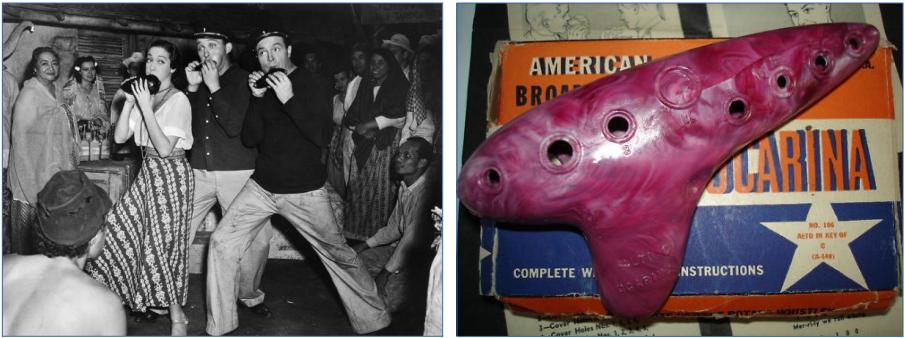
Bing Crosby, Bob Hope, and Dorothy Lamour Play. A 1940s Gretsch Ocarina. (ExplorePAHistory.com.com, Campin.me.uk)
Ocarinas got a big boost when Ziegner Swanson invented an "inline" or linear ocarina in the late 1930s. This plastic oc, called the tonette, looks like a stubby end-blown flute. The US Army gave thousands to the troops during World War II. The Army also distributed plastic Gretsch oc's to the soldiers, along with fingering charts and songbooks.
More significantly, the tonette became a staple of early childhood education during the 1940s, 1950s, and 1960s. In this role it competed with the song flute and the flutophone as the vehicle to introduce American schoolchildren to music. Tens of millions of these instruments were distributed for educational purposes. Their popularity only declined when inexpensive plastic recorders became widely available in the 1970s and 1980s.
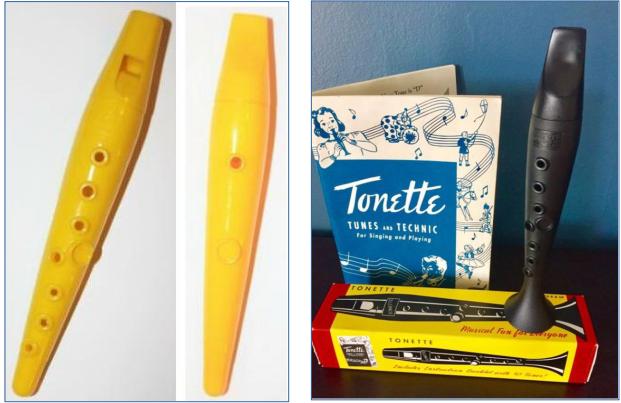
Tonettes Were Very Popular in Schools (Photos courtesy of Gibson and Ebay)
Japanese Improvements
In 1928, Japanese craftsman Takashi Aketagawa took the standard 10-hole European transverse ocarina invented by Giuseppe Donati and further developed it. He added two more small holes, or "sub-holes," that extended the range of the instrument from 11 to 13 whole notes. We refer to this instrument today as the "12-hole transverse ocarina."
Nomura Sojiro popularized Aketagawa's design when he unveiled his original ocarina compositions in the film, "The Great Yellow River," in the 1980s. This led to an explosion of interest in the ocarina in the far east, all based on the 13-note Asian ocarina design. Today the ocarina is viewed as a serious instrument in Japan, China, Taiwan, Korea, and other Asian nations. Everyone from students, to hobbyists, to professionals play and perform with the instrument.

Click to Hear Nomura Sojiro Play Great Yellow River (Youtube.com, Takashi Aketagawa Museum)
English Inventions
Since Guiseppe Donati in 1850s, the most common shape of musically-playable ocarina has been the submarine or "transverse" form. Occasionally one would see an "inline" shaped instrument, such as the tonette.
In 1964, an English mathematician named John Taylor took the instrument in an entirely new direction. He adopted the globular shape of many ancient vessel flutes and made it into a fully capable musical instrument. He developed a four-hole ocarina that could play an entire eight note musical scale.

John Taylor and Two Ocarinas Based on His Fingering System (TNG Ocarinas, OcarinaForest.com, OcarinaWind)
This became the modern 4- or 6- hole pendant or seedpod ocarina familiar to us today. The six hole pendant is the same as the four hole, except that adds two thumb holes beneath the instrument. This extends its range from eight to ten whole notes. Given this range advantage, the six hole design predominates.
Both 4- and 6- hole ocarinas play all sharps and flats within their range. Note that, while you simply lift your fingers in order to ascend the scale with transverse and inline ocarinas, Taylor's seedpod design is a bit different. One must memorize the fingering patterns for the various notes in the scale.
Taylor's invention popularized the notion of wearing the instrument on a lanyard or necklace. One can easily wear either a small clay seedpod or a lightweight plastic one in this manner. Hence, the popular designation, pendant.
The Legend Of Zelda
One of the most popular video game series of all time is "The Legend Of Zelda." The product exploded upon the gamer scene when Nintendo first released it in the 1980s. Since then it's been ported to many platforms and has seen numerous versions, releases, and spin-offs right up to the present time.
LOZ's main character is named Link. Dressed in forest garb like Robin Hood, he carries his transverse ocarina attached to a lanyard looped about his neck. At various times Link relaxes or meditates by playing his oc. Link's ocarina songs accompany the LOZ gaming series and comprise its theme songs. This idea culminated with the 1998 release of "The Legend of Zelda: Ocarina of Time."

Click to Hear a Zelda Medley. To the Right, Link Plays His Oc. (STL Ocarina at Youtube.com, Playing.AssociationNewsTV.com)
It's hard to overstate the impact of the Legend Of Zelda on the ocarina's popularity in the United States. Many fans first took up the instrument due to their love of the video game. The LOZ songs have become so well-known that they're often played as standards when testing or comparing modern ocarinas.
Fun Shapes
Based on John Taylor's innovation, it becomes possible to make musically-capable ocarinas in a variety of interesting shapes. You use Taylor's pendant fingering system to play these oc's. This photo shows a dolphin, a dragon's egg, a turtle, and a tea cup. All are true musical instruments (not whistles). You can both drink from the tea cup, and play tunes on it!
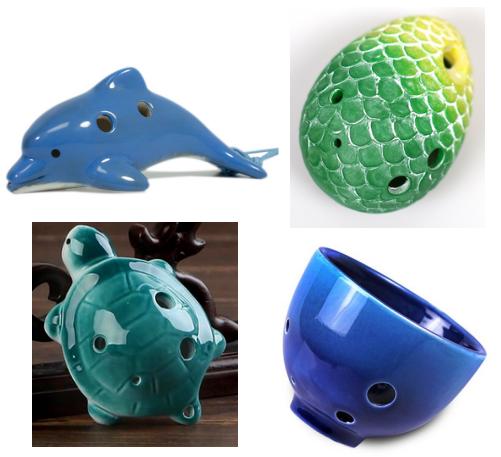
Fun Playable Ocarinas (EBay and STLOcarinas.com)
Not all cute oc's are playable, however. You can distinguish musical oc's from ornamental whistles by inspecting the size of the fingering holes. True musical instruments feature different-sized holes; whistles typically have holes that are all one size. Take a close look at these lovely collectibles and you'll see that none are musical instruments:

Collectibles, Not Playable Musical Instruments (Vendors photos)
Extended Range Ocarinas
Two important limitations keep the ocarina from being considered a "concert instrument." First, the great majority cannot be tuned. They are one-piece instruments without the ability to move a mouthpiece in or out to tune the instrument (one exception is the tonette).
Second, ocarinas have a limited range. The greatest range belongs to the popular 12-hole tranverse oc. It features 13 whole notes and all intervening sharps and flats.
To address the range issue, ocarinas with two or even three chambers have been developed. The blue oc below shows how the player selects the instrument's chamber by where he places his mouth. Then he moves his hand to the appropriate set of finger holes for that chamber. Thus, a player can achieve two or even three full octaves with a multi-chambered ocarina.
The inline ocarina on to right is the recent invention of Karl Ahrens, founder of the company Mountain Ocarinas. His invention allows players to cover finger holes for both chambers simultaneously. So they merely move their lips when they select which chamber to play.
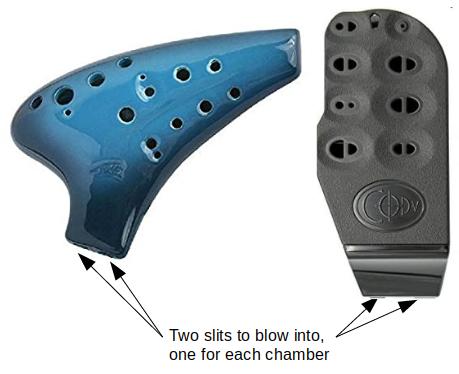
Dual Chamber Ocarinas (Vendors photos)
Given their complexity and lack of standardization, dual- and triple- chambered ocarinas are mainly the province of advanced players.
Ocarinas Today
So where does all this leave us?
Today fans play ocarinas world-wide. Unique regional traditions continue in Italy, the UK, Germany, and other European nations, not to mention Japan, China, Taiwan, and Korea in the far east. Interest in North America has been booming ever since video game hero Link made the little instrument his own. Latin America continues a proud tradition of beautiful ornamental ocarinas. Some are fully playable musical instruments, while others are collectible ornamental whistles.
Here is a quick summary of the modern ocarina ...
Materials -- They are typically made of ceramic clay, plastic, or sometimes wood. On rare occasions, you may run into one made of metal or even some other material.
Shapes -- Playable ocarinas group into three categories:
- Transverse -- The traditional submarine or sweet potato design standardized by Giuseppe Donati, today most often encountered with 12 holes
- Inline -- An end-blown variant that fingers similar to the transverse
- Seedpod or Pendant -- 4- or 6- hole variants, often shaped like ancient globular ocarinas. Special shapes are possible, too, such as animal designs or other fun concepts. These use the fingering system invented by John Taylor.
This photo shows two transverses on the left, two inlines in the middle, and two seedpods on the right.
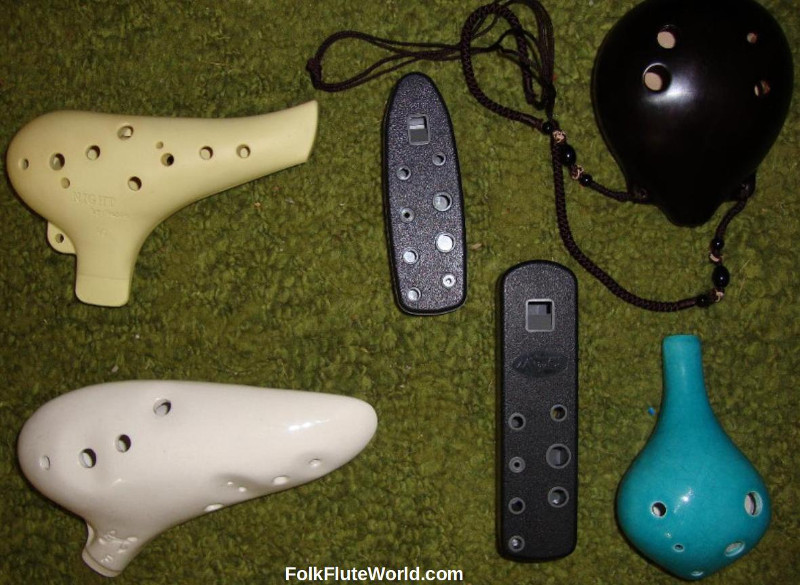
Ocarina Shapes
Keys -- Ocarinas are available in every imaginable key. But most still follow the the scheme laid out by Donati nearly two centuries ago:
| Name: | Key: | Base Note (lowest note): |
| Soprano in C | C | C6 (same as sopranino recorder) |
| Soprano | G | G5 |
| Alto | C | C5 (same as soprano recorder) |
| Tenor | G | G4 |
| Bass | C | C4 (same as tenor recorder) |
| Contrabass | G | G3 |
Note that ocarina terminology is notoriously unstandardized, so some vendors use other classification systems. (For example, STL Ocarina in the United States calls the "Alto C" in this chart its "Tenor in C Major", etc.)
Playable Ocarinas Vs Collectibles -- Both playable oc's and collectible whistles come in a variety of fun shapes. Just be certain you know which you're buying when you purchase one!
Mechanical Keys -- Sporadic historical attempts to affix a key or two onto ocarinas, or even a slide, have never caught on. The ocarina retains its beauty as a simple, keyless vessel flute.
Last Words
I hope you've enjoyed this quick history of the venerable ocarina. No instrument is easier to learn, and for the price of a dinner, you can acquire a musical instrument that will last you a lifetime. For what a single concert flute or saxophone costs, you can build an extensive collection.
Everything you need to play -- lessons, sheet music, and more -- is available for free. Check out our free sheet music downloads here. And our links to free video lessons here.
And finally, our links to lots of other free sources here.
Enjoy!